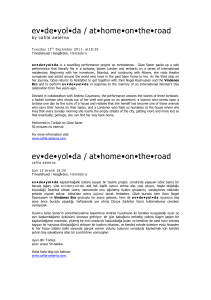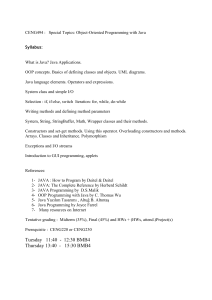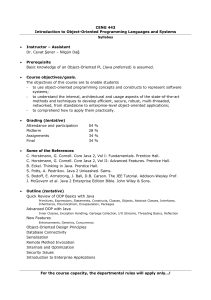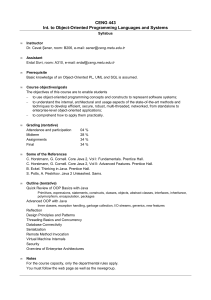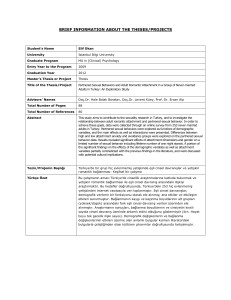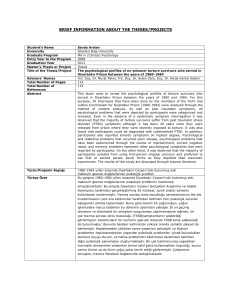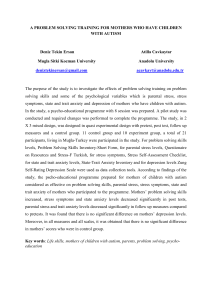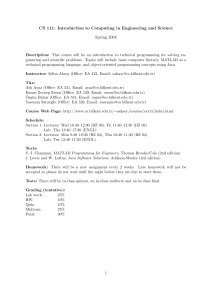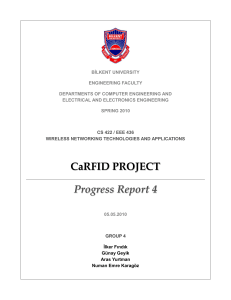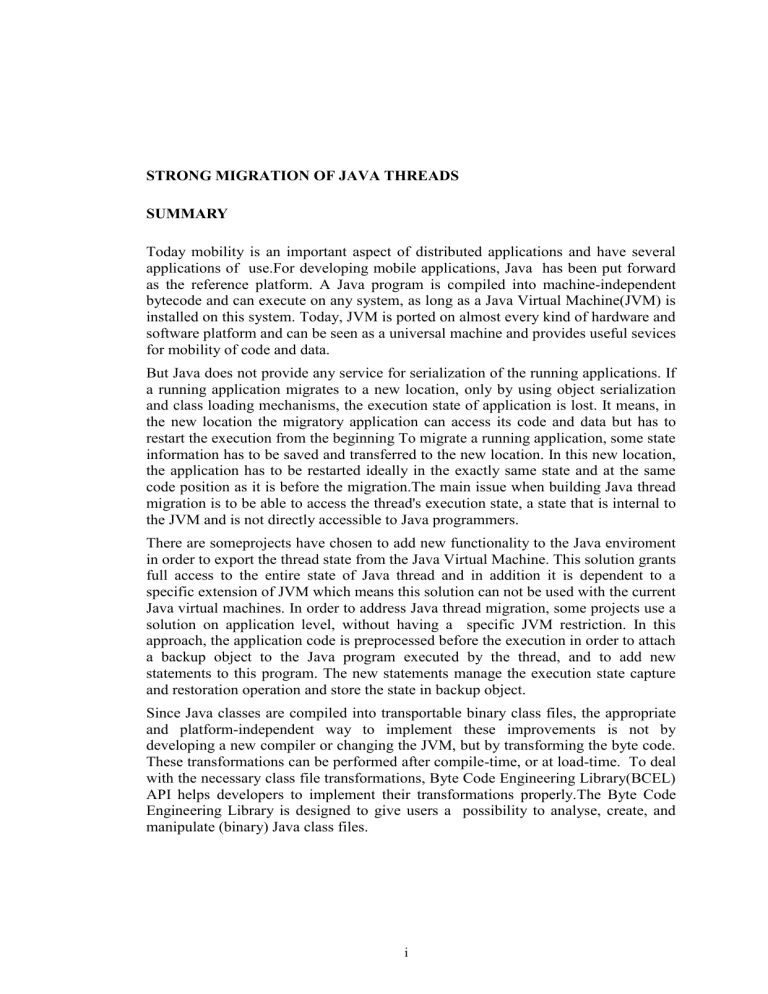
STRONG MIGRATION OF JAVA THREADS
SUMMARY
Today mobility is an important aspect of distributed applications and have several
applications of use.For developing mobile applications, Java has been put forward
as the reference platform. A Java program is compiled into machine-independent
bytecode and can execute on any system, as long as a Java Virtual Machine(JVM) is
installed on this system. Today, JVM is ported on almost every kind of hardware and
software platform and can be seen as a universal machine and provides useful sevices
for mobility of code and data.
But Java does not provide any service for serialization of the running applications. If
a running application migrates to a new location, only by using object serialization
and class loading mechanisms, the execution state of application is lost. It means, in
the new location the migratory application can access its code and data but has to
restart the execution from the beginning To migrate a running application, some state
information has to be saved and transferred to the new location. In this new location,
the application has to be restarted ideally in the exactly same state and at the same
code position as it is before the migration.The main issue when building Java thread
migration is to be able to access the thread's execution state, a state that is internal to
the JVM and is not directly accessible to Java programmers.
There are someprojects have chosen to add new functionality to the Java enviroment
in order to export the thread state from the Java Virtual Machine. This solution grants
full access to the entire state of Java thread and in addition it is dependent to a
specific extension of JVM which means this solution can not be used with the current
Java virtual machines. In order to address Java thread migration, some projects use a
solution on application level, without having a specific JVM restriction. In this
approach, the application code is preprocessed before the execution in order to attach
a backup object to the Java program executed by the thread, and to add new
statements to this program. The new statements manage the execution state capture
and restoration operation and store the state in backup object.
Since Java classes are compiled into transportable binary class files, the appropriate
and platform-independent way to implement these improvements is not by
developing a new compiler or changing the JVM, but by transforming the byte code.
These transformations can be performed after compile-time, or at load-time. To deal
with the necessary class file transformations, Byte Code Engineering Library(BCEL)
API helps developers to implement their transformations properly.The Byte Code
Engineering Library is designed to give users a possibility to analyse, create, and
manipulate (binary) Java class files.
i
Brakes thread serialization technique is described in the context of middle ware
support. It presents a simple execution model that guarantees correct thread
migration semantics when moving a thread to another location.This thread
serialization mechanism is implemented by extracting the state of a running thread
from the application code that is running in that thread. To extract the state of a
running thread, a byte code transformer modifies the application code by inserting
code blocks that perform the actual capturing and reestablishing of the current
thread's state. So this thread migration mechanism is portable across standard JVM
platforms.Brakes offers tasks as a complement to JVM threads, in order to perform
this thread serialization mechanism practical for migration. The JVM thread is
encapsulated by a task, whose exectuion state is same with its threads execution
state. Context object is defined for each task and the captured/reeastblished execution
state is hold within this Context object.Transformer generates state capturing and
state reestablishing code blocks in the application code.
But Brakes is not designed for migration between different JVMs.We will propose an
extension to Brakes, named RemoteBrakes, to be able to move the threads between
different JVM instances and allow context-switching between tasks within different
JVMs.
By using Remote Method Invocation (RMI) of Java, an object running in one Java
virtual machine to invoke methods on an object running in another Java virtual
machine.
In this work, two different kind of applications are developed with
RemoteBrakes&RMI integration. In this first application a distributed matrix
calculation is demonstrated, one of the threads migrates in middle of its job and
continues at the new JVM within a different task object. Second application is a
Bouncing Balls application, one of the balls migrates to the other JVM with its task.
With this application, migration is visual and you can track the path of the migrator
ball.
The cost of Strong Migration of Java threads, is 11% to 20% space overhead on
application codes.
ii
JAVA İPLİKLERİNİN BAĞLAM BİLGİSİYLE BİRLİKTE GÖÇ ETTİRİLMESİ
ÖZET
Günümüzde mobilite/göç edebilirilik dağıtılmış uygulamalar için önemli bir konudur ve
kullanılabileceği pek çok alan mevcuttur. Mobil uygulamalar geliştirmek için Java referans
platform olmuştur. Bir Java programında makine bağımsız bytecode derlenir ve üzerinde
Java Sanal Makinesi (JVM) kurulu olan tüm sistemlerde çalıştırılabilir. Bugün, JVM hemen
hemen her tür donanım ve yazılım platformuna taşınmıştır, dolayısıyla evrensel bir makine
olarak görülebilir. Vaynı zamanda kod ve veri taşınabilirliği için yararlı servisler sunmaktadır.
Fakat Java uygulamaları çalışma zamanında serileştirme için herhangi bir hizmet sağlamaz.
Eğer çalışmakta olan bir uygulama, yalnızca nesne serileştirme ve sınıf yükleme
mekanizmaları kullanarak yeni bir konuma göç ettirilirse, uygulamanın bağlam bilgisi
kaybolur. Göçmen uygulamanın koduna ve verisine erişebilirsiniz ancak uygulamaya
çalışmaya kaldığı yerden değil de baştan başlar. Çalışma zamanındaki bir uygulamayı göç
ettirdiğimizde o zamana kadarki bağlamının korunmuş olmasını ve göç ettiği yerde kaldığı
yerden çalışmasını bekleriz. Burada karşımıza çıkan sorun JVM'in bu yürütme bilgilerini
programcılara vermemesi ve kendi içinde saklamasıdır.
Bazı mevcut projelerde Java ipliklerinin bağlam bilgilerine erişmek için JVM üzerinde
değişiklik yapılmıştır. Böylelikle JVM'in normalde programcıya vermediği bilgilere
erişilmiştir ancak Javanın platform bağımsızlığı ilkesi sekteye uğramıştır, çünkü bu bilgiye
ulaşabilmek için değiştirilmiş JVM kullanmak zorunda kalınacaktır. Java ipliklerinin bağlam
bilgilerine ulaşmak için diğer bir yöntem uygulama seviyesinde bu bilgilere ulaşmayı
hedeflemiştir. Uygulama koduna eklenen bazı kod parçalarıyla ipliklerin bağlam bilgilerini
saklanması ve gerektiğinde aktarıldığı yerde baştan yüklenmesi sağlanmıştır.
Java sınıflarının platform bağımsızlığı korumak için gerekli değişikliklerin bytecode
seviyesinde yapılması en mantıklı çözümdür. ByteCode Mühendislik Kütüphanesi Uygulama
Geliştirme Arayüzü(BCEL API) sayesinde bağlam bilgilerini alabilmek için gerekli
değişiklikleri bytecode seviyesinde yapabiliriz. BCEL kullanıcılara bytecode analizi, baştan
yaratmak ve değişiklik yapmak için gerekli tüm yapıları sunmaktadır.
Brakes İplik serileştirme mekanizmasıyla basit bir yürütme modeli kullanarak ipliklerin
bağlam bilgisiyle göç ettirilmesi sağlanmaktadır. ByteCode Değiştirme mekanizmasıyla
bağlam bilgisi saklayan ve yükleyen kodlar uygulamaya bytecode seviyesinde eklenir.
Dolayısıyla Javanın platform bağımsızlığı korunmuş olur. Brakes ByteCode Değiştirme
mekanizmasını yanı sıra her bir ipliği bir Görev (Task) ile ilişkilendirir ve görevin bağlamı ile
ipliğin bağlamı aynı olacak şekilde bir yapı kurar. Görev içinde taskın bağlamının tutulduğu
özel bir sınıf olan Bağlam bulunur. Bytecode seviyesinde eklenen kodlar bu Bağlam sınıfını
güncelleyerek gerekli bağlam bilgisini tutmuş olur.
3
Ama Brakes farklı JVM'ler arasında göç için tasarlanmış değildir. Biz Brakes için, farklı JVM
arasında göçü mümkün kılan ve bağlamları farklı görevler arasında taşımaya da izin veren
RemoteBrakes adında bir eklenti önermekteyiz.
Bir nesnenin başka bir Java sanal makinede çalıştıran yöntemleri çağırmasına olanak veren
Uzaktan Yöntem Invocation (RMI) kullanarak JVMler arası göçü sağlayacağız.
Bu çalışmada, iki farklı türde RemoteBrakes & RMI ile entegrasyon uygulaması
geliştirilmiştir. İlk uygulamada Dağıtılmış bir matris hesaplama gerçeklenmiştir, ve
ipliklerden bir tanesi işinin ortasında JVM 'e göç edip çalışmasına başka bir görev nesnesi
içinde devam edebilmektedir. Ikinci uygulama Seken Toplar uygulamasıdır, burada da bir
topun (ipliğin ve görevin) başka bir JVM'e göç etmesi ve çalışmasına kaldığı yerden devam
etmesi simüle edilmiştir. Bu uygulamayla topların hareketleri görsel olarak takip
edilebildiğinden demo amaçlı bir uygulamadır.
Bağlam bilgisiyle beraber göç edebilmenin maliyeti kodların boyutunda %11 ile %20
civarında bir artıştır.
4


